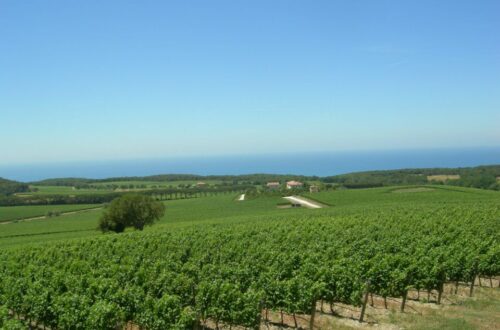Table of Contents
What is Carema DOC?
Carema DOC is one of Piedmont’s most captivating wine appellations — a small but storied enclave producing mountain-grown Nebbiolo that embodies “heroic viticulture.” Perched at the foothills of the Alps on the border with Valle d’Aosta, its steep, terraced vineyards are held in place by centuries-old stone pillars (“pilun”) and pergolas known as topie, creating a unique alpine amphitheater where Nebbiolo ripens slowly, developing finesse, spice, and haunting aromatics.
History & Origins
Winegrowing here dates back to Roman times, when the terraces were carved into the slopes to maximize sun exposure. Carema’s wines were once treasured by Turin’s Savoy court, and by the mid-20th century, their rarity had already made them a connoisseur’s secret.
The DOC was established in 1967, making it one of Piedmont’s earliest recognized appellations. Today, production remains tiny — barely enough to supply dedicated collectors and travelers who make the pilgrimage to this mountain hamlet.
Where It’s Made: Geography & Terroir
- Location: Northwestern Piedmont, bordering Valle d’Aosta
- Vineyards: 300–600 meters above sea level, south-facing
- Soils: Morainic origin — sandy, rocky, rich in minerals from ancient glaciers
- Climate: Alpine-moderated — warm days, cool nights, extended ripening season
The dramatic temperature shifts create Nebbiolo wines with elevated aromatics, fine tannins, and vibrant acidity — a style distinct from the more powerful Barolo and Barbaresco.
The Grape
Nebbiolo (locally called Picotendro) dominates Carema DOC wines, with up to 15% of authorized local varieties like Nebbiolo Rosé, Ner d’Ala, and Pugnet permitted. These small additions can lend subtle softness or aromatic lift.
Winemaking & DOC Regulations
- Minimum Nebbiolo content: 85%
- Aging: Minimum 36 months (of which at least 24 in oak or chestnut casks)
- Carema Riserva: Minimum 48 months aging, with greater complexity and longevity
- Alcohol: Minimum 12%
- Style: Always dry, with signature notes of dried rose, alpine herbs, and earthy minerality
Key Facts at a Glance
- DOC Established: 1967
- Primary Grape: Nebbiolo (Picotendro)
- Annual Production: ~40,000 bottles
- Climate: Alpine foothill, continental influences
- Style: Elegant, aromatic, age-worthy reds
Tasting Notes
Appearance: Pale garnet with brick-orange reflections
Aromas: Dried rose petals, wild strawberries, alpine herbs, crushed stone, sweet spices
Palate: Silky yet structured, with fine-grained tannins, bright acidity, and a long, savory finish
Aging Potential: 10–20 years in top vintages
Serving & Pairing
- Ideal Temperature: 16–18°C (slightly cooler than most reds)
- Glassware: Large Burgundy bowl to enhance aromatics
- Pairings:
- Piedmontese classics: Bagna càuda, tajarin with butter and sage, bollito misto
- Alpine dishes: venison stew, polenta with mushrooms
- Mature cheeses: Castelmagno, Fontina d’Alpeggio
- Piedmontese classics: Bagna càuda, tajarin with butter and sage, bollito misto
Where to Buy & Pricing
Carema DOC is rare — seek it from specialist Italian wine merchants or direct from producers.
- Ferrando: Benchmark producer, especially the Etichetta Nera Riserva
- Produttori di Carema: Historic cooperative, great value
- SorPasso & Monte Maletto: New-generation estates
Price Range: €25–€60, Riserva often higher
Carema vs. Barolo vs. Ghemme
| Feature | Carema DOC | Barolo DOCG | Ghemme DOCG |
| Style | Elegant, alpine, floral | Powerful, tannic | Structured, earthy |
| Altitude | 300–600m | 200–450m | 250–350m |
| Aging | 36–48 months | 38–62 months | 34–46 months |
| Production | ~40k bottles | Millions | ~150k bottles |
Wine Tourism Tips
Carema is best experienced in autumn, when the vineyards glow gold.
- Visit: Ferrando’s historic cellars, Produttori di Carema’s tasting room
- Events: Carema Prima (spring release), Festa dell’Uva (September harvest festival)
- Nearby: Explore Valle d’Aosta castles, Gran Paradiso National Park, and Turin’s vibrant food scene
FAQ on Carema DOC
Q: What makes Carema different from Barolo or Ghemme?
A: Its altitude and alpine terroir create lighter, more floral Nebbiolo with high aromatics.
Q: Is Carema age-worthy?
A: Yes — top examples evolve beautifully for 15–20 years.
Q: Why is Carema called “heroic viticulture”?
A: The steep terraces require all vineyard work by hand, often on precarious slopes.
Q: Where can I taste Carema in Piedmont?
A: In Carema village itself, or at wine bars in Turin specializing in rare Piedmont wines.
Fun Facts & Cultural Notes
- The stone pilun pillars store daytime heat, protecting grapes from cool nights.
- Carema’s terraces are UNESCO heritage candidates for their cultural and agricultural value.
- Local legend says Nebbiolo here “breathes mountain air” — a nod to its freshness.
Producer Directory
- Ferrando – Iconic, age-worthy expressions
- Produttori di Carema – Cooperative with classic style
- SorPasso – Small-batch, artisanal approach
- Monte Maletto – New estate reviving abandoned terraces
CTA
💬 Have you tasted Carema DOC? Share your impressions or your favorite pairing with the Drink Italian community below. Your story could inspire another wine lover’s journey into Piedmont’s alpine treasures.


